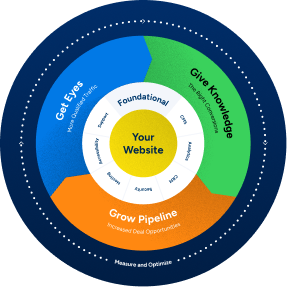Many business-to-consumer marketing strategies currently focus almost solely on social media messaging and advertisements. However, many B2B buyers still prefer email campaigns for many reasons. Building a strong email marketing strategy allows your firm to meet buyers and offer solutions.
Discover why email campaigns are still a cornerstone for any successful B2B marketing strategy.
Does Email Marketing Work for B2B Companies?
At its core, an effective email marketing strategy utilizes email as the primary content method. Email captured leads and allows website visitors to create or nurture a long-term client relationship. This will vary in many key ways from a successful B2C email marketing strategy. We’ve all seen our inboxes filled to bursting with a list of subject lines that contain pithy quips, excessive use of emojis/punctuation, and maxims designed to tug at the heartstrings. While B2C email marketing depends on impulse and emotion. B2B email campaigns need to be based on logic, reasoning, and the promise of filling a gap or need for the client company.
Types of Email Marketing Strategies and B2B Marketing Lead Generation
There are infinite iterations of email marketing strategies being used in the B2B digital space at this very moment, but most of them can be crystallized into a few overarching silos. Read on to learn which types of email messages which strategies are best to bring in highly desirable leads for B2B companies in Boston.
The Welcome Email
Just like first impressions matter in the real world, so goes the digital B2B realm. Ideally, this is the email that is sent to a new prospect. This email has either visited your website or been impressed enough with your B2B company branding and authority that they have already decided to open up their inbox to your offerings. Welcome emails are overwhelmingly the most read types of B2B emails. Almost 60% of those sent are opened and read. A welcome email should contain a “thank you for partnering with us” type message. In addition, links to relevant products and services, along with the option to request more detailed or customized information simply by clicking a link in the message.
Brand Stories
Sharing the experiences or evolution of your B2B business is a powerful way to set the tone for a long-term relationship. Though B2B email messages are not tailored to be as emotive as B2C marketing tactics, brand stories should illuminate facets of your products, services, company culture, or altruistic efforts that are likely to increase a business decision maker’s opinion of your brand.
Tips and Tutorials
This method is another way of strengthening your brand. Helpful tips or step-by-step guides on how to solve common industry problems are often highly useful for B2B company decision-makers. Tutorials often build trust and respect for your brand as an authority that also anticipates the needs of potential and existing clients.
Re-Engagement Emails
If your analytics reports indicate that your email subscribers are not opening your messages, or if they are being opened but there is no action (like a clickthru) by the subscriber, an attempt to regain the attention may allow for win-back or a return to interest. Subject lines like “we miss you” or “did you forget to take advantage of this solution?” actually boast a rate of about 10% leading to re-engagement. Just like you, B2B decision-makers are busy. Often the lack of interaction or contact has not occurred because the potential client has gone to a competitor. Or because the lead is disinterested in what your email marketing B2B strategy has put on offer. But rather, that a heavy workload has pushed your message off the top of their email list.
Promotional Emails
These are often time-sensitive. They rely on that good old fear of missing out (FOMO) that B2B purchasers target within their B2C personal life. Setting a deadline with a quickly approaching expiration date for a generous offer. Or the limited availability of a popular product or service has been known to generate an increase in conversions from leads who have never made a purchase with your company. In addition, an increase in long-term clients who have been working with the same vendor for years.
What Metrics Should You Measure for a B2B Email Campaign?
The overall return on your B2B email campaign investment will determine if your efforts are making money. You may need to adapt to realign your B2B company goals. The standard formula is to assign a value to the clients gained, subtract the spend on the campaign, and then divide by total spend. The average ROI for B2B email marketing is $36 for every $1 spent. However, this can vary greatly due to industry and company size.
There are many yardsticks by which the efficacy of an email marketing campaign measures. The key performance indicators for a B2B email campaign categories are below:
- Bounce Rate – What percentage of emails were not successfully delivered to the inboxes on your mailing list?
- Open Rate – What percentage of the recipients of your email have opened it?
- Click-Through Rate (CTR) – This is the best indicator of how each email is performing since this is the number of recipients who opened the email and engaged with the content by clicking a link.
- Conversion Rate – Slightly similar to click-through rate, conversion rate gives you the percentage of recipients who received an email call to action and completed that action, such as filling out a survey or information form to request more information.
Ready to Start Email Marketing to Boost your B2B ROI?
At GoingClear, our experts have placed dozens of B2B companies in a stronger position by implementing new email marketing campaigns or tweaking existing ones. Team members are standing by to partner with your B2B company in Boston. We’re beyond to ensure you are getting the most bang for your buck!

